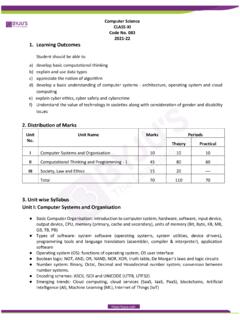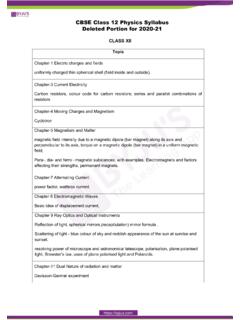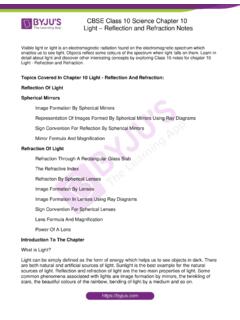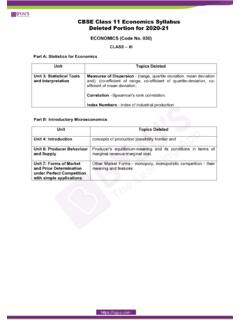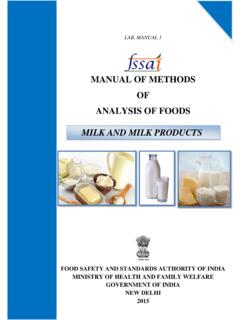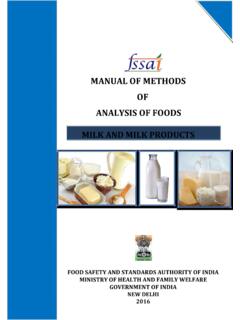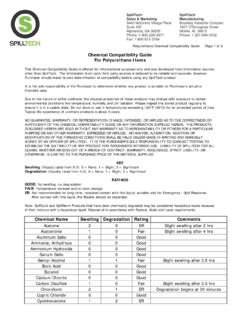Transcription of CBSE Class 11 Chemistry Deleted Syllabus Portion for 2020-21
1 Chemistry (043) Class XI S No Unit Portion to be Reduced 1 Some Basic Concepts of Chemistry Nature of matter, laws of chemical combination, Dalton's atomic theory: concept of elements, atoms and molecules. 2 Structure of Atom Discovery of Electron, Proton and Neutron, atomic number, isotopes and isobars. Thomson's model and its limitations. Rutherford's model and its limitations 3 Classification of Elements and Periodicity in Properties Significance of classification, brief history of the development of periodic table, 4 Chemical Bonding and Molecular Structure -- 5 States of Matter: Gases and Liquids liquefaction of gases, critical temperature, kinetic energy and molecular speeds (elementary idea), Liquid State- vapour pressure, viscosity and surface tension (qualitative idea only, no mathematical derivations) 6 Chemical Thermodynamics Heat capacity and specific heat capacity, Criteria for equilibrium 7 Equilibrium hydrolysis of salts (elementary idea), Henderson Equation 8 Redox Reactions applications of redox reactions 9 hydrogen Preparation, properties and uses of hydrogen , hydrogen peroxide -preparation, reactionsand structure and use; 10 s -Block Elements Preparation and Properties of Some Important Compounds: Sodium Carbonate, Sodium Chloride, Sodium Hydroxide and Sodium hydrogen carbonate, Biological importance of Sodium and Potassium.
2 Calcium Oxide and Calcium Carbonate and their industrial uses, biological importance of Magnesium and Calcium. 11 Some p -Block Elements Some important compounds: Borax, Boric acid, Boron Hydrides, Aluminium: Reactions with acids and alkalies, uses. Carbon: uses of some important compounds: oxides. Important compounds of Silicon and a few uses: Silicon Tetrachloride, Silicones, Silicates and Zeolites, their uses. 12 Organic Chemistry : Some basic Principles and Techniques methods of purification, qualitative and quantitative analysis 13 Hydrocarbons free radical mechanism of halogenation, combustion and pyrolysis. 14 Environmental Chemistry Entire chapter CBSE Class 11 Chemistry Syllabus Deleted Portion for 2020-21 Practical The following Portion to be Deleted C. Experiments based onpH a) Any one of the following experiments: determination of pH of some solutions obtained from fruit juices, solution of known and varied concentrations of acids, bases and salts using pH paper or universal indicator.
3 Comparing the pH of solutions of strong and weak acids of same concentration. Study the pH change in the titration of a strong base using universal indicator. b) Study the pH change by common-ion in case of weak acids and weak bases. D. Chemical Equilibrium One of the following experiments: a) Study the shift in equilibrium between ferric ions and thiocyanate ions by increasing/decreasing the concentration of either of theions. b) Study the shift in equilibrium between [Co(H2O)6]2+ and chloride ions by changing the concentration of either of theions.
